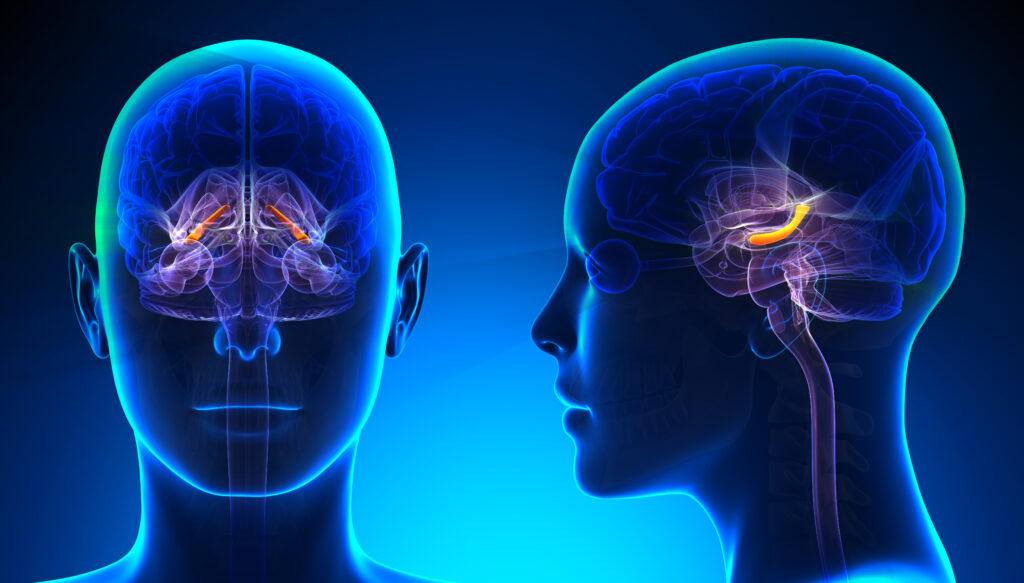Scientists have long wondered how the hippocampus alternates episodic memory formation and recall. While we know that these two competing processes – learning and remembering – are controlled by the hippocampus, scientists have struggled to observe how the brain knows when and how to shift from recalling past information to learning and responding to novel information. That’s because, historically, it has been almost impossible to study the brain’s response to absolute novelty. But a new animal model study using virtual reality is changing that.
Competing Forces in the Hippocampus
As the brain structure that largely controls learning and memory, the hippocampus is always taking in new information. Therefore, it is highly sensitive to external stimuli. It recalls past experiences to understand and make decisions in the present, while also imagining and planning for the future. And when we encounter an entirely novel object or event, the hippocampus switches from recall to learning in order to understand new information or situations as they arise in real time.
The unique ability of the hippocampus to seamlessly transition between recall and learning and back again has long stumped researchers. This is, in part, because learning and recall are conflicting processes that compete against each other. Scientists know that this unlikely balancing act between learning and recall occurs in the hippocampus; what has long been unknown is how, exactly, the hippocampus is able to seamlessly transition between the two.
Pairing Animal Model Research with Virtual Reality
Until recently, research into how the hippocampus transitions between learning and recall has been at an impasse for one key reason: it is nearly impossible to study absolute novelty’s effects on the brain, even in an animal model. But a new study authored by scientists at Institut Pasteur may have found a way to solve the absolute novelty problem by combining an animal study with virtual reality.
As Ruy Gómez-Ocádiz, a Ph.D. student and the study’s first author explains, “We realized that the main obstacle to studying how the brain reacts to novelty was physical reality itself. We could easily overcome this problem if only we could ‘teleport’ a mouse to a new room as we record its brain.”
Gómez-Ocádiz knows that this idea sounds like a plot point to a Star Trek episode. But, as he explains, “This might sound like science fiction, but virtual reality technology allowed us to do precisely that.”
How did the Institut Pasteur team pull this study off? By designing a video game that the mice in the study could “play” in a virtual world. The mice were rewarded for following the game’s rules, and then, using virtual reality technology, researchers were able to “teleport” the mice to an entirely new world in an instant.
Under these conditions, for the first time, researchers were able to observe the activity which occurs in the hippocampus at the precise moment of transition between recall and learning.
What the Institut Pasteur Study Reveals
Through this study, researchers were able to observe an electric signal in the hippocampus that occurred at the exact moment the mice were “teleported” into a brand-new virtual world. In other words, they were able to observe the electric signal the hippocampus emits at the exact moment it transitions between recall and learning.
This electric signal, which is emitted by granule cells when a novel situation is encountered, is what activates the shift between neural states: from neural memory to neural learning.
The research team, along with physicists from the École normale supérieure – PSL and the French National Centre for Scientific Research (CNRS), have been able to use this new information to create a computational model that suggests ways in which this signal might act as a “switch” that tells the brain when to transition from remembering to learning, and vice-versa.
More research will be needed to fully understand how this hippocampal signal works, but the initial findings are a promising start. Ongoing research into the histology of the hippocampus using animal models and virtual reality may continue to shed further light on how humans and animals learn new information.
Scantox is a part of Scantox, a GLP/GCP-compliant contract research organization (CRO) delivering the highest grade of Discovery, Regulatory Toxicology and CMC/Analytical services since 1977. Scantox focuses on preclinical studies related to central nervous system (CNS) diseases, rare diseases, and mental disorders. With highly predictive disease models available on site and unparalleled preclinical experience, Scantox can handle most CNS drug development needs for biopharmaceutical companies of all sizes. For more information about Scantox, visit www.scantox.com.

